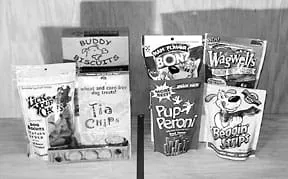There are two types of people in the world: Those who give their dogs treats, and those who don’t, ever. I think all of us here belong in the former group. Right? Everyone with me? Good.
We are all aware that we could make our own dogs treats rather than buy them. Some of us do make our dogs’ treats, sometimes. But there is something special about buying snacks for our dogs – sort of like buying Popsicles from the ice cream man for the kids; it may be expensive, and impulsive, and foolish. But so what? The joyous little doggie dance that dogs do when they know you’ve got something yummy for them is worth any price.
Actually, feeding treats to your dog is not all whimsy – far from it. Regular readers of WDJ know that food is the most powerful tool we have to motivate a dog to pay attention to us. And once they understand that they can get humans to give them treats by performing various tasks, most dogs get downright desperate to perform. “Sit? Down? Shake hands? High five? You say the word, boss, and I’ll do it; just keep those biscuits coming!”
Our regular readers also know that we talk about dog food in every issue of WDJ. We discuss homemade diets constantly, review dry dog foods every February and canned foods every October, and occasionally talk about innovations such as commercially freeze dried foods, frozen raw diets, and fermented foods.
We talk about food so obsessively because the quality and type of food that you feed your dog probably has a greater impact on his health than any other factor in his life. With all other factors being equal, dogs who eat better food will be healthier. And there is just no sense in feeding your dog great food and then slipping him awful, chemical-laden treats!
Support health
So, in general, we suggest looking for treats that support the same general philosophy that guides your dog food purchases, with a couple of exceptions. While they are sometimes formulated to meet the standards for “complete and balanced” nutrition set by the Association of American Feed Control Officials (AAFCO) for dogs, they don’t have to be; your dog won’t be surviving on these and nothing else. But neither should they contain nutrients in amounts that so radically depart from a dog’s daily diet that their consumption (even in small amounts) would completely imbalance his diet.
Also, some dogs are intolerant or allergic to certain food ingredients. Obviously, you have to shop for treats that do not contain those ingredients; even the small amount that a sensitive dog might consume in an occasional treat could set off a reaction. Fortunately, as long as you are aware of what specific ingredient your dog can’t tolerate, it should be even easier to find a treat without it than a dog food; there are probably even more special-formula treats available for dogs than there are special-formula dog foods. Interestingly, there are a number of treat manufacturers who claim to have started their businesses because they couldn’t find a commercial source of treats that met the special dietary consideration of their own allergic or sensitive dogs.
Palatability issues
On the next page, we discuss some of traits we like to see in a treat, and some things we think that treats really shouldn’t contain. Our “likes/dislikes” lists are pretty clear, until you come to the issue of palatability enhancers. Generally, whenever we talk about dog foods, we say that products that contain good-quality ingredients won’t need palatability enhancers to attract dogs to eat them. But treats are supposed to make dogs especially enthusiastic, motivated, and gratified, so they should taste extra nice. For this reason, we don’t mind seeing some palatability enhancement in a treat recipe. But we do insist that it’s still a natural, healthy enhancer – natural sweeteners over artificial ones, for example.
This consideration caused us some unexpected angst in the category of meat-based treats. We found a handful of meaty treats that – from arm’s length – looked like healthy, delicious candidates. We naively thought that these treats would be the purest available, since two were comprised largely of dried salmon, and two were mostly venison – what more would you need to thrill a dog? But in each case, we were disappointed to discover that the dried meats were loaded with additional palatability enhancers – salt, sugar, and artificial additives such as smoke flavor. What’s up with that? Compared to the products we rated “one-bone” (do not buy!), however, the additives are a mere sprinkling, so these products get our “two-bone” rating.
You’ll have to guess whether your dog will be motivated by grain-based treats; pungent flavors such as cheese, salt, anise, or peanut butter; sweets (molasses, sugar, or honey); or if he’s a meat-eatin’-only kind of guy. Don’t hesitate to try something new! He might surprise you and develop a healthy craving for cheese or apple flavors.
We have noticed that many dogs who have been trained with treats are so conditioned to expect something yummy from you, that they don’t seem to really care when the treat you hand them is not all that tasty – they would happily crunch and swallow a dirt clod or two before they caught on. Other dogs are motivated only by what our Training Editor, Pat Miller, calls “high-value” treats: fragrant and delicious confections. Sometimes it takes a while to find the treat that makes your dog do somersaults.
Other considerations
Because we advocate every imaginable type of positive-reinforcement training, we end up feeding our dogs a lot of treats. (Often, you can train the dog with his own dinner- kibble as a reward, only using higher-value treats for learning new or demanding tricks that beg for greater motivation.) For training purposes, it’s best if the treats are very small. If a dog received a paw-sized biscuit every time he did something right in a training session, he’d be corpulent in no time. So, while we can easily break up a large treat into tiny pieces for training, we especially appreciate manufacturers who deliver their tasty wares in tiny sizes.
We also enjoy it when a treat maker has an especially engaging or amusing package. We know that seems shallow! But we also know that attractively packaged dog treats make great, inexpensive gifts for our dog-loving friends – and most of our friends love dogs! Our amusement does not, however, extend to the “fake human food” school of presentation that is so popular among the big-name, grocery-store treats. Generally, the use of chemical humectants and artificial colors (both on our list of no-no’s) are required to make treats look like bacon, ham bones, sausages, etc. And it’s not like our dogs appreciate the effort!
On a more practical note, when the treats come in an easily recloseable container (we like plastic jars and zipper-type plastic bags), it’s a bonus. These containers keep the treats from losing flavor and freshness.
Finally, note that this is not – obviously – a list of every treat maker in the country. Rather, we wanted to show you a few samples of some of the treats that we think are absolutely the best, some that are just fine and dandy, and some that we think you ought to avoid, and highlight the features that helped us make those distinctions. Then, if it’s not already listed here, you can compare the list of ingredients and determine where on our scale your dog’s favorite treat would fit. The following chart is arranged alphabetically by rating.
Also With This Article
Click here to view “Whole Dog Journal’s Approved Dry Dog Food List”
Click here to view “Healthy Dog Treats”
-by Nancy Kerns









Where’s the referenced chart for dog treats?
Looking for the referenced chart of dog treats too!!